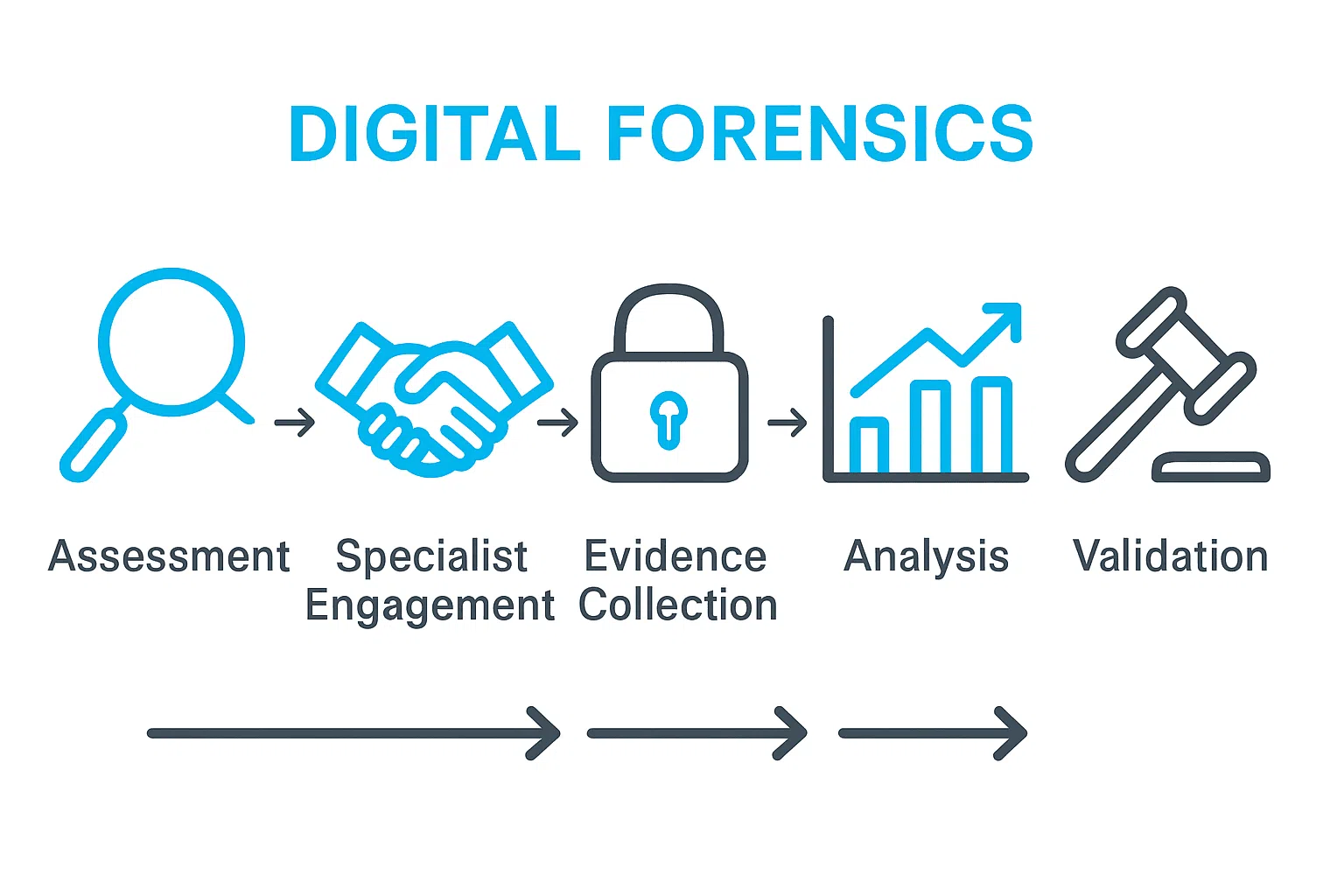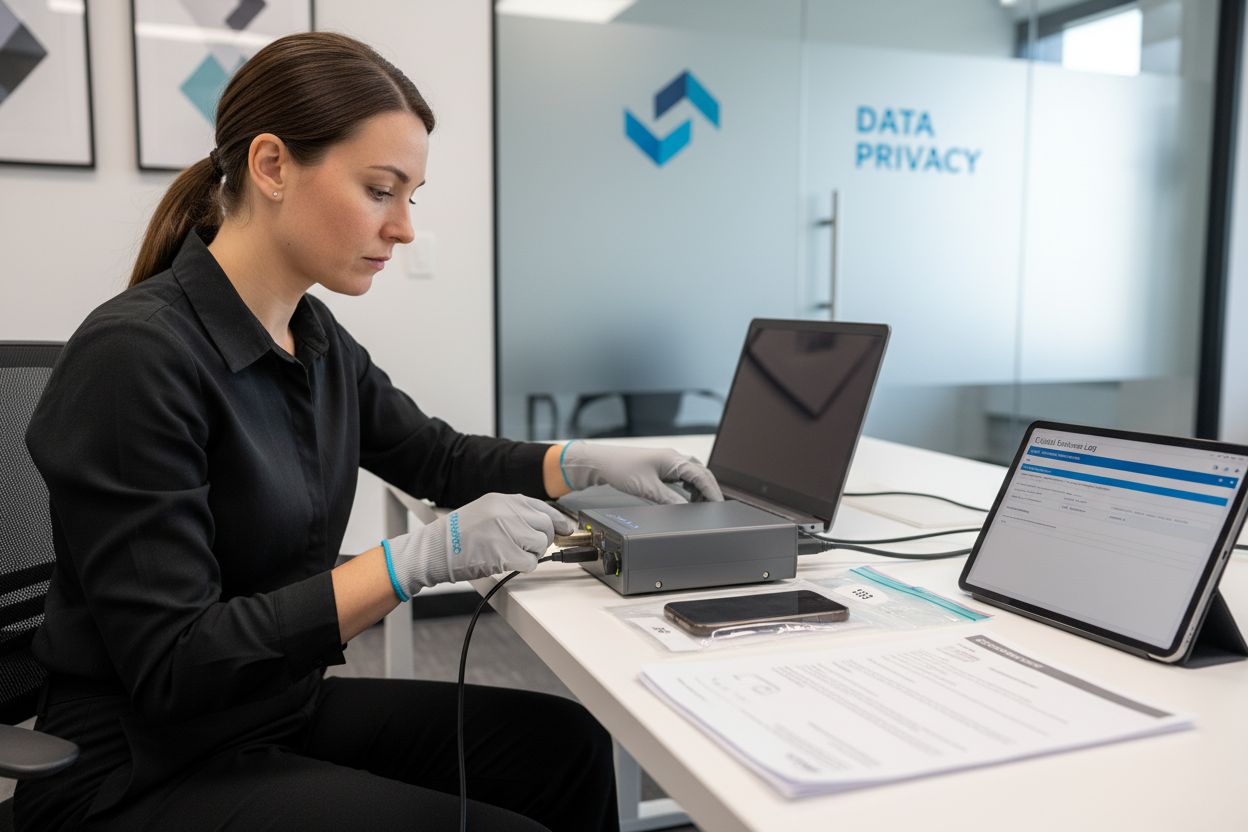Nearly 80 percent of UK organizations have faced some form of digital incident over the past year, highlighting how vital effective digital investigations have become. Digital evidence now shapes outcomes in disputes, cybersecurity responses, and even criminal cases. Knowing how to assess your needs and work with digital forensic experts makes all the difference when every piece of data matters.
Table of Contents
- Step 1: Assess Your Digital Investigation Needs
- Step 2: Engage Digital Forensics Specialists Securely
- Step 3: Collect and Preserve Critical Digital Evidence
- Step 4: Analyze Data to Uncover Actionable Insights
- Step 5: Validate Findings for Legal and Corporate Use
Quick Summary
| Key Point | Explanation |
|---|---|
| 1. Assess Your Digital Investigation Needs | Identify specific requirements to guide your forensic approach effectively. Understanding needs is critical for successful investigations. |
| 2. Engage Certified Digital Forensics Specialists | Ensure specialists have recognized credentials and legal knowledge for secure evidence management. Choose experts with relevant experience for your case type. |
| 3. Collect and Preserve Evidence Meticulously | Follow rigorous methods to maintain evidence integrity. Document processes carefully to create a reliable chain of custody. |
| 4. Analyze Data for Actionable Insights | Use specialized tools to uncover meaningful information from digital evidence. Approach analysis without bias to accurately present findings. |
| 5. Validate Findings for Legal Standards | Validate your forensic evidence thoroughly to ensure admissibility in court. Maintain detailed records and methods for scrutiny during legal proceedings. |
Step 1: Assess Your Digital Investigation Needs
Understanding your specific digital investigation needs is the critical first step in securing expert forensic support. According to research from Lancashire University, a comprehensive needs assessment within UK police forces revealed 125 distinct requirements for effectively handling digital evidence and cybercrime.
Begin by conducting an honest internal review of your current digital challenge. Are you dealing with potential employee misconduct? Investigating a suspected data breach? Gathering evidence for litigation? Each scenario requires a tailored forensic approach.

Infographics showing five steps of digital forensics process with icons.
The National Institute of Standards and Technology (NIST) emphasizes that understanding your precise investigative requirements ensures more reliable and effective forensic techniques.
When assessing your needs, consider several key factors:
Here’s a summary of key factors to assess during your digital investigation needs evaluation:
| Factor | Why It Matters | Typical Considerations |
|---|---|---|
| Device Type | Determines forensic methods | Computers Mobile phones Cloud storage |
| Data Needed | Guides analysis approach | Deleted files Emails System logs |
| Legal Implications | Affects compliance requirements | Litigation Regulatory HR policy |
| Timeline | Influences investigation urgency | Immediate breach Routine audit |
- The type of digital devices involved (computers, mobile phones, cloud storage)
- The specific data you need to recover or analyse
- The potential legal or corporate implications of the investigation
- Your timeline and urgency for results
Pro Tip: Be as specific as possible about your investigation goals. The more detailed information you can provide to digital forensics specialists, the more targeted and efficient their approach will be.
Once you have clearly defined your investigation needs, you will be well prepared to engage a digital forensics specialist who can precisely match their expertise to your specific requirements.
Read our guide on UK Digital Forensic Investigations for more comprehensive insights into preparing for a digital forensic examination.
Step 2: Engage Digital Forensics Specialists Securely
Engaging a digital forensics specialist requires careful consideration to protect the integrity of your investigation and ensure legal compliance. According to the United Nations Office on Drugs and Crime (UNODC), selecting specialists who understand their legal and ethical obligations is paramount for secure digital evidence management.
Start by conducting thorough due diligence on potential forensics specialists. Look for professionals with recognized certifications demonstrating their expertise and adherence to industry standards. The National Institute of Justice emphasizes the importance of specialists who have undergone standardized education and training protocols.
Key considerations when engaging digital forensics specialists include:
- Verifying professional credentials and certifications
- Checking their experience with similar investigation types
- Understanding their approach to maintaining evidence chain of custody
- Confirming their ability to provide expert witness testimony if required
Pro Tip: Always request detailed information about the specialist’s methodology and request sample reports from previous investigations to assess their thoroughness and professionalism.
When you initiate contact, be prepared to provide a clear but confidential overview of your investigation requirements. A reputable digital forensics specialist will ask detailed questions to understand the scope of your needs while maintaining strict confidentiality.
Learn more about selecting the right expert in our guide on how a digital forensic specialist can help with investigations, which offers additional insights into making an informed choice.
Step 3: Collect and Preserve Critical Digital Evidence
Collecting and preserving digital evidence requires meticulous attention to detail and rigorous scientific methodology. According to research from the National Institute of Standards and Technology (NIST), establishing robust computer science methods is crucial for ensuring the reliability of digital evidence in forensic investigations.
Begin by creating a comprehensive forensic image of all relevant digital devices. This means making an exact bit by bit copy of the entire storage system without altering any original data. Research from Staffordshire University emphasizes that proper acquisition techniques are fundamental to maintaining the integrity of digital evidence.
Key steps in collecting and preserving digital evidence include:
- Documenting the initial state of all devices before any forensic work begins
- Using write blockers to prevent accidental modification of original data
- Creating forensically sound bit stream images of storage devices
- Generating cryptographic hash values to verify evidence integrity
- Maintaining a detailed log of all actions taken during evidence collection
Pro Tip: Always work on copies of the original evidence and never directly on source devices to prevent potential contamination or unintended modifications.
Each piece of digital evidence must be carefully handled with a clear chain of custody. This means tracking who accessed the evidence, when, and under what circumstances. Your documentation should be so precise that another forensic expert could replicate your entire process.

Digital Forensics At Work Extracting Data From a Mobile Phone
Learn more about best practices in our guide on essential digital evidence preservation methods, which provides in depth insights into maintaining forensic standards.
Step 4: Analyze Data to Uncover Actionable Insights
Analyzing digital evidence requires sophisticated techniques to transform raw data into meaningful insights. According to the National Institute of Standards and Technology (NIST), digital investigation techniques are crucial for extracting reliable and actionable information from complex digital systems.
Begin by utilizing specialized forensic analysis tools that can systematically examine different file systems and data sources. Research from Staffordshire University highlights the importance of understanding various operating system structures and file allocation methods to effectively extract critical information.
Key strategies for effective data analysis include:
- Recovering deleted files and examining file metadata
- Identifying unusual system activities or potential security breaches
- Correlating timestamps and user activities across multiple devices
- Reconstructing digital timelines of events
- Detecting patterns of potentially suspicious behaviour
Pro Tip: Always maintain a neutral and objective approach during analysis. Your goal is to uncover factual evidence without introducing personal bias or preconceived conclusions.
Pay special attention to metadata and system logs, as these often contain crucial information that might not be immediately visible. Digital forensics specialists can uncover hidden connections and patterns that could be pivotal to your investigation.
For more comprehensive insights, explore our guide on understanding digital forensic analysis techniques, which provides deeper understanding of forensic investigation methodologies.
Step 5: Validate Findings for Legal and Corporate Use
Validating digital forensic findings is a critical process that ensures your evidence meets rigorous legal and professional standards. According to the National Institute of Standards and Technology (NIST), forensic findings must undergo comprehensive validation to guarantee their admissibility and reliability in legal contexts.
The validation process requires a systematic approach to documenting and substantiating every aspect of your digital investigation. Research from Staffordshire University emphasizes the importance of creating comprehensive documentation that can withstand intense legal scrutiny.
Key steps in validating forensic findings include:
- Verifying the integrity of all collected digital evidence
- Creating detailed documentation of investigation methodologies
- Ensuring all forensic procedures follow established legal standards
- Preparing clear and concise expert reports
- Cross referencing findings with multiple independent sources
Pro Tip: Consider having an independent forensic expert review your findings to provide an additional layer of credibility and objectivity.
Prepare your documentation as if it will be thoroughly examined in a courtroom. Each piece of evidence should be traceable and its collection method should be transparently explained. This means maintaining a meticulous chain of custody and providing clear technical explanations that can be understood by legal professionals without specialized technical knowledge.
For deeper insights into preparing legally sound digital evidence, explore our guide on digital forensics in litigation, which offers comprehensive strategies for legal documentation.
Unlock Expert Digital Forensics Support to Solve Your Investigation Challenges
If you are navigating the complexities of digital evidence collection, data recovery, or analysing cyber incidents, the practical guide has illuminated how crucial precise forensic expertise is to your success. You understand the need for meticulous handling of digital devices, secure preservation of evidence, and dependable analysis to reveal actionable insights for legal or corporate use. This is where partnering with seasoned specialists becomes indispensable to overcome challenges like maintaining chain of custody, uncovering deleted or hidden data, and supporting regulatory compliance.
At Computer Forensics Lab, based in London, our skilled team offers tailored solutions designed to match your investigation needs. Whether your circumstances involve sophisticated computer intrusions or internal issues requiring thorough digital examination, our Forensic Computing Investigation services deliver precise and reliable forensic results. For cases involving cyber attacks, consider our focused Computer Hacking Examination expertise. Every step we take is aligned with best practices highlighted in the guide ensuring integrity and legal admissibility.
Don’t leave your digital investigation to chance. Act now to ensure your evidence is collected, preserved, and analysed securely and thoroughly. Visit Computer Forensics Lab to connect with experts ready to support your case with confidence and professionalism.
Frequently Asked Questions
How can digital forensics specialists help with data breach investigations?
Digital forensics specialists can identify how a data breach occurred by analyzing compromised systems and recovering lost data. Start by engaging a specialist who can create a forensic image of your affected devices within 48 hours to preserve evidence.
What steps should I take to prepare for hiring a digital forensics expert?
Before hiring, assess your specific digital investigation needs by clarifying the type of devices involved and the data you require. Document these needs in detail, as providing comprehensive information will enable the expert to tailor their approach effectively.
What are the typical legal implications of digital forensics?
Digital forensics can involve significant legal considerations, such as compliance with data protection laws and evidence admissibility in court. Ensure that any digital forensics expert you choose understands these legal implications and can provide documentation that meets legal standards.
How long does a digital forensics investigation usually take?
The duration of a digital forensics investigation can vary greatly depending on the complexity of the case, with some investigations completed within a week and others taking several months. Communicate your timeline expectations to the forensics expert upfront to establish a realistic schedule for your investigation.
What types of evidence can digital forensics specialists recover?
Digital forensics specialists can recover various types of evidence, including deleted files, emails, and system logs. To maximize your chances of recovery, ensure that no additional data is overwritten, and engage a specialist promptly after a potential data loss incident.
How do I validate the findings of a digital forensic investigation?
Validating findings requires a thorough review of the evidence’s integrity and the methods used during the investigation. Create a clear documentation log of all forensic procedures and consider obtaining a secondary review from another expert to enhance the credibility of the findings.
